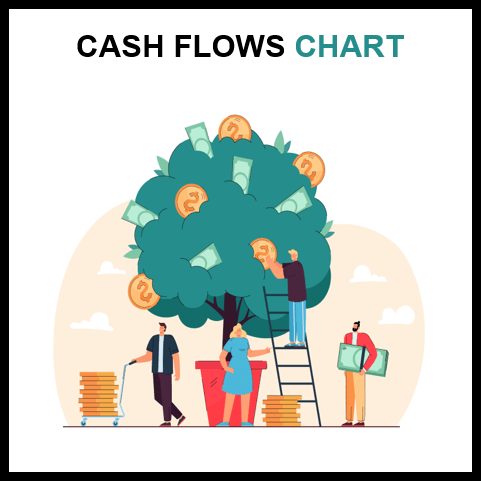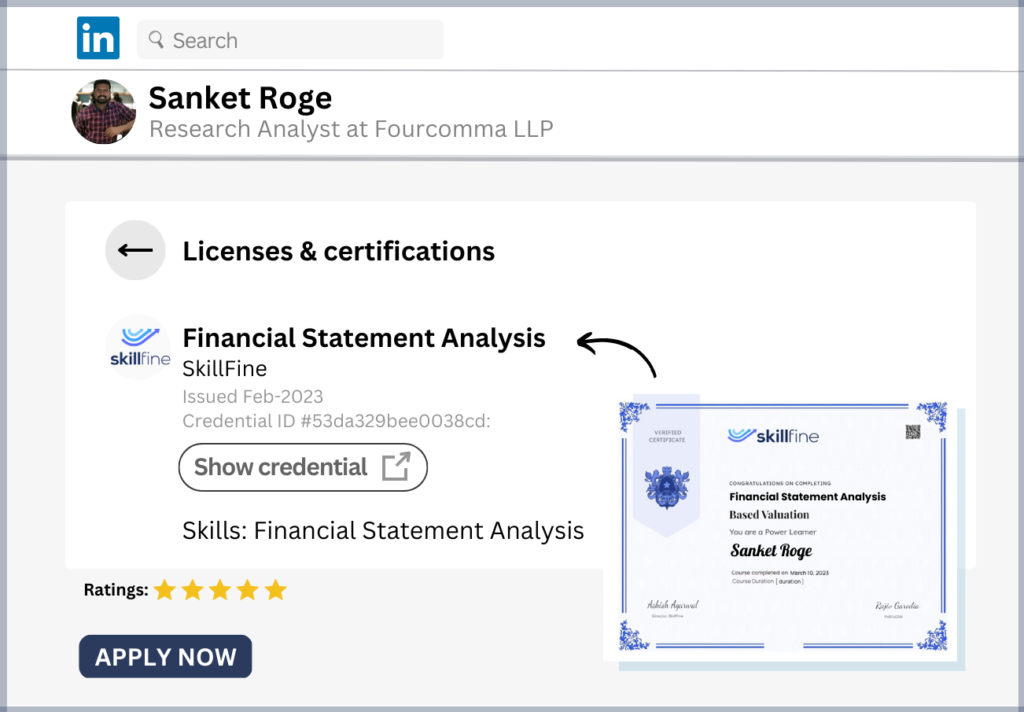What are Cash Flow Charts
Cash flow chart is a significant document that helps in implementing or understanding the financial management of a firm. Cash flow chart traces all the origins and the uses of cash of a particular period. It aids in tracking all cash flows, cash receipts and disbursements for a particular period. It helps in explaining how one passes from the balance sheet of the year X-1 to the balance sheet of the year X. This is the reason why it is said that it primarily provides a dynamic view of balance sheets.
It is a great analytical tool that is wonderful in bringing a real added value to the financial analysis process. It is very significant to know how to read and interpret financial statements and integrate it into the overall approach of financial analysis.
How to make a cash flow chart?
The steps to make a cash flow chart are as follows –
Step 1- Start by creating a rough draught before creating a large scale version of a chart. Now draw a box at the top of a sheet of paper for each type of revenue the organisation generates. Government tax credits, licensing fees, asset sales, equity are some of the options you need to include and then examine your company’s financial records in detail.
Step 2- Now draw boxes in the middle of the page for each spending authority part of the company. Draw boxes for each of the hats if you have no other employees but we are wearing different hats and spending business money such as secretaries hats and facilities managers hats.
Step 3- draw smaller boxes under its spending authority box to identify specific areas of expenditure. List the amount spent in the most recent accounting period to next each box and add them up and write the total in the box next to the spending authority. Double check all figures for accuracy.
Step 4- Connect any spending authority box that derives its budget from that source of income to each income box at the top of the page. To avoid the jumbled mass of lines you might wish to use different colour markers.
Step 5- Examine the chart for mistakes and consider how you might improve the visual design to draw attention to the information on the page. Lastly, using markers on a large piece of paper suited for presenting meetings and displaying them on the wall, create a much larger final version of the chart.
Different ways to present cash flow statements
This statement of cash flows aka cash flow statements is one of the significant financial statements that shows how much money was made and spent over a period of time. By demonstrating how many went in and out of the business, the statement of cash flows serves as a link between the income statement and balance sheet.
There are two different methods of presenting cash flow statements and they are as follows:
Direct method- the direct approach discloses the primary categories of gross cash receipts and gross cash payments.
Businesses that uses the direct approach should report the following types of operating cash receipts and payments separately:
- Money collected from clients, such as lessees, licensees, and others.
- Receive interest and dividends.
- Other cash receipts from operations, if any.
- Interest that has been paid.
- Tax that has been paid.
- Insurance advertising and other similar expenses are paid in cash to employees and other supplies of goods or services.
- Any other cash payment for operations.
Companies that employ the direct method must provide a separate schedule in the financial statements that reconcile net income to net cash flow from operating operations.
The direct technique gives information that is not available under the indirect method and hence is deemed more suited than the indirect method for projecting future cash flows.
Information regarding key classes of gross cash receipts and gross cash payments can be obtained using the direct technique in one of two ways:
- Based on the company’s accounting records.
- In the profit and loss statement, by adjusting sales, cost of sales which is interest and similar revenue and interest expenditure and similar charges for a financial enterprise and other items.
Indirect method: the net cash flow from operational processes is calculated using the indirect approach by adjusting net profit or loss for the effects of:
- Changes in inventories and operational receivables and payables over the period
- Depreciation, provisions, deferred taxes, and unrealized foreign exchange gains and losses are examples of non-cash items.
- Investing and financing cash flows are the only other items that have a cash effect.
Alternatively, the net cash flow from operations can be shown indirectly, indicating operating revenue and costs, except for the non-cash items reported in the statement of profit and loss as well as changes in stocks and operating receivable and payable items over the period.
The indirect method begins with net earnings and reconciles it with net cash flow from business. Operating cash flow is determined by adjusting net income to current asset and liability changes, and depreciation costs.
Cash flow is not the cost of depreciation. As net income diminishes, the net income is returned to the operational cash flow. The indirect technique is utilised more commonly as it displays the connection between the income balance sheet and thus, it helps in the analysis.
Top cash flow graphs every business should use
Cash flow graph is a fast and efficient approach to gain a good view of cash flow in and out of your company. Cash flow charts can help you comprehend what is happening with the cash of a company in one look, whether you want to get into more granular, specific information or more about overview of your cash situation.
A company shall take note of the cash available both at the start and the end of the certain period to calculate cash flow. The time frame can be a week or a month for example. If more is in the accounts at the conclusion of the period then the period begins and less is negative, the company will have a positive cash flow.
Good management of cash flow is one of the best things you can do for your business. Not just this, but also your personal financial, it is a competence that you can take over in the ventures.
Top cash flow graph every business should use are as follows:
- Cash flow forecast graph- for any organisation, regardless of form or size, it is crucial to forecast your cash. A strong cash flow forecast is like magic, which shows your future bank balance and makes the necessary decisions to maintain your corporate cash flow. If your cash flow is still calculated with spreadsheets, you will more likely never have the joy to see your projection magnificently in a simple but efficient cash flow diagram.
- Budget vs actual graph- the successful budgeting of cash flow hinges on an awareness of where you have been under budget. Step in the budget versus the actual chart. This cash flow graph records your actual budgets and provides the information in a magnificent and visual style. Before it comes to matter you can identify overspending and not spending hours in a spreadsheet.
- Scenario planning Graphs- the third when is the scenario planning graph. Scenario planning will allow you to model mote ji so that you can see how they affect the cash flow of your company. Scenarios can be used to prepare everything from fluctuating seasonal cash to employing new employees. You can not only create the scenario by examining a beautiful new graph, but also you can lead the scenarios out and download them to a comparison graph.
Enhancing cash flow is an intelligent strategy for every company. How big your business plan is, how lucrative you are or how many investors you’ve formed, if you cannot control the financial flow of your organisation you won’t survive.
Best courses to learn about cash flow charts
To kick start your career in this very interesting field, you can take various courses that would prove very beneficial for you to learn cash flow graphs and charts and various other financial statements. Let’s take a look at the list of courses that are highly recommended for you.
- Business finance fundamentals for entrepreneurs– under this course you will be able to master how to create a new business financial model. The skills that you would be able to embark on are very very much in demand. You’d be able to be comfortable with finance terminologies, master in creating a business and financial model of your company, identifying key value drivers of your business, assessing future business projections of key metrics.
You’ll also learn estimating the external funding to be raised from investors, how negotiating the percent of equity dilution to investors happens, and estimating the valuation of a business. The course has various models that will make you learn with practical based examples and with very good engagement and interaction.
- Business Finance Fundamentals for Non-Finance professionals– under this course you will be able to master the complete fundamentals in accounting finance and business valuation. The skills you will learn are business Finance fundamentals, accounting fundamentals, financial analysis comparison, business valuation, financial forecasting techniques, business plan, financial ratios, key financial statements, and so on.
The best expert under this course will make you learn everything with practical knowledge. He will make you learn everything from the basic introduction and then to the pro level. Some of the modules include- understanding the statements of the Alpha, annual report, IC turnover for Alpha, calculating coverage ratio for Alpha, ranking of leverage metric and so on.
- Financial Statement Analysis– the course is all about practical illustrations based learning in order to create income statements and balance sheets of any company. Under this course you will be able to learn to prepare the accounting statements of a company, income statement of a company, balance sheet of a company, and a linkage between income statement and balance sheet of a company.
The course is very interesting which will help you understand key financial statements, accounting terms and why we need them, along with the proper basic introduction of the entire course.
This course is then followed by quizzes and practice assignments with an easy level. Everything they would teach would be from scratch and thus anyone who doesn’t have the basic knowledge and still wants to learn financial statements, can take up this course.
- A Complete Guide To Cash Flows Statement– you’ll be able to learn a detailed breakdown of the cash flow statement and how to create it. The key insights it provides on financial performances is also included in this course. Under this course, you will be able to master three basic financial statements, income statement and balance sheet, profits versus cash flows, cash flow statement breakdown, and then how to create a cash flow statement.
Future Scope-
Using cash flow statements and charts verified profitability and liquidity positions. It helps in verifying capital cash balances, it helps in cash management, planning and coordination. The cash flow chart is superior over the accrual basis of accounting. Looking at all of these advantages or benefits of cash flow charts, we are really noticing a high demand for analysts.
The future scope of cash flow charts is crystal clear. Taking the important courses and entering into this field can prove to be very beneficial. Anyone who is good at analysis and calculating can definitely try coming up in this field.
Conclusion-
All registered companies are obligated to prepare a cash flow report in accordance with the updated account in standard together with the balance sheet and revenue statement. It is emphasized that this statement of class flow is essentially separated from the statement of balance sheet of the state of income. Thus, it is very much crucial for every company or a firm.




One thought on “Cash Flow Charts: A Comprehensive Guide from Skillfin Learning”
Great, thanks for sharing this article post.Much thanks again. Much obliged.